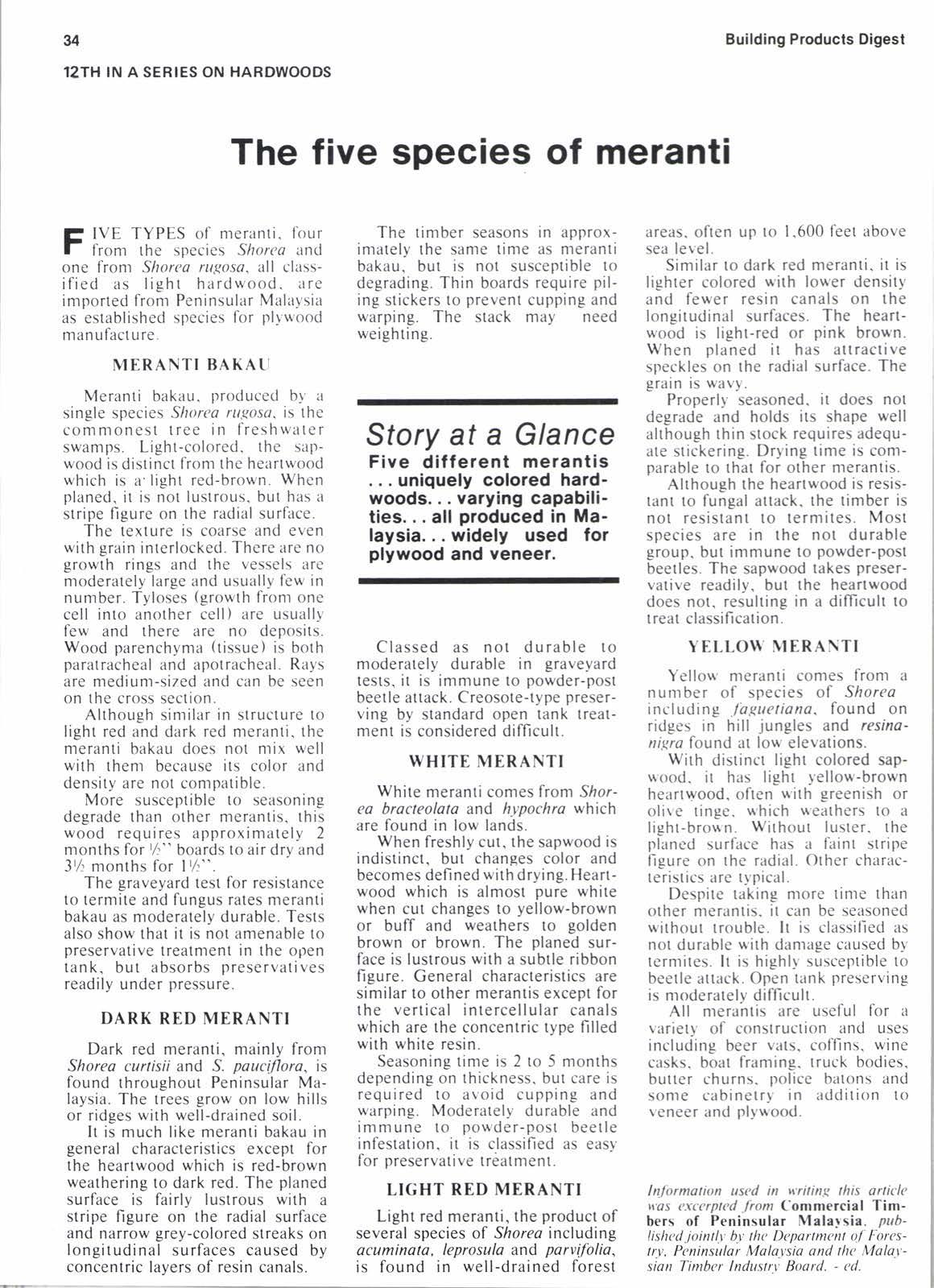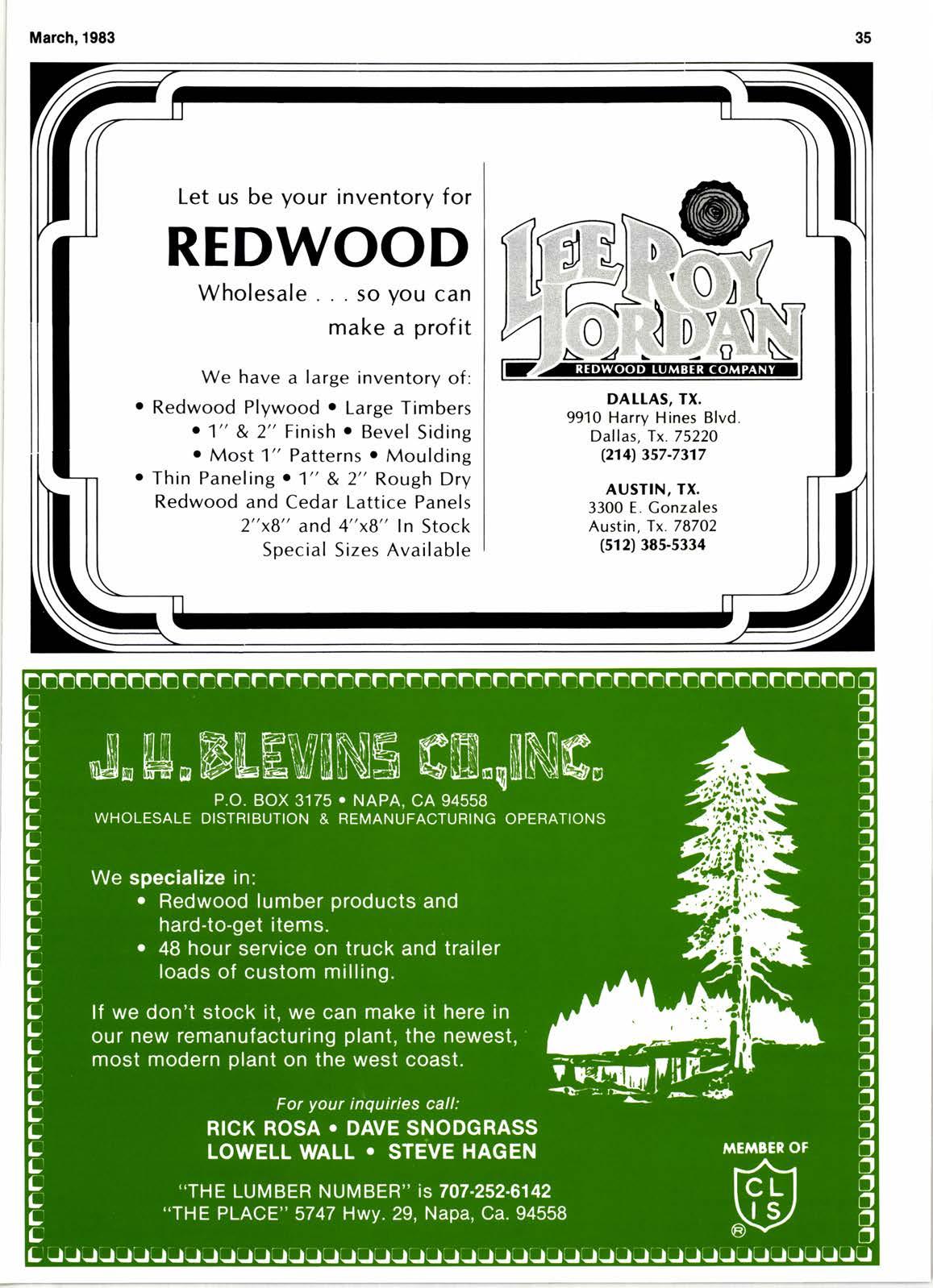
3 minute read
The five species of meranti
E IVE TYPES of nreranti, four f I'ronr the snecies Shorea and one fronr Shorcla rugosa. all classified as light hardwood. are imported fronr Peninsular Malal'sia as established species lor pl1'wood man ufact u re.
Meranti Bakati
Meranti bakau, produced b1' a singf e species Shorea rugosa. is the commonest tree in freshwater swamps. Light-colored. the sapwood is distinct fronr the heartwood which is a'light red-brown. When planed. it is not lustrous, but has a stripe figure on the radial surface.
The texture is coarse and even with grain interlocked. There are no growth rings and the vessels are moderately large and usually few in number. Tyloses (growth fronr one cell into another cell) are usualll' few and there are no deposils. Wood parenchyma (tissue) is both paratracheal and apotracheal. Rays are mediunr-sized and can be seen on the cross section.
Although similar in structure to light red and dark red meranti, the meranti bakau does not nrix well with them because its color and density are not compatible.
More susceptible to seasoning degrade than other merantis, this wood requires approximately 2 months for r/:" boards to air dry and 3rl: months for |/:".
The graveyard test for resistance to termite and fungus rates meranti bakau as moderately durable. Tests also show that it is not amenable to preservative treatment in the open tank, but absorbs preservatives readily under pressure.
Dark Red Meranti
Dark red meranti, mainly from Shorea curtisii and S. pauciflora, is found throughout Peninsular Malaysia. The trees grow on low hills or ridges with well-drained soil.
It is much like meranti bakau in general characteristics except for the heartwood which is red-brown weathering to dark red. The planed surface is fairly lustrous with a stripe figure on the radial surface and narrow grey-colored streaks on longitudinal surfaces caused by concentric layers of resin canals.
The timber seasons in approxinrately the same time as n'reranti bakau, but is not susceptible to degrading. Thin boards require piling stickers to prevent cupping and warping. The stack may need weighting.
Story at a Glance
Five different merantas . . . uniquely colored hardwoods. . . varying capabilities. all produced in Malaysia. widely used for plywood and Yeneer.
Classed as not durable to moderately durable in graveyard tests. it is immune to powder-post beetle attack. Creosote-type preserving by standard open tank treatment is considered difficult.
White Meranti
White meranti comes from Shorea bracteolata and hypochra which are found in low lands.
When freshly cut, the sapwood is indistinct. but changes color and becomes defined with drying. Heartwood which is almost pure white when cut changes to yellow-brown or buff and weathers to golden brown or brown. The planed surface is lustrous with a subtle ribbon figure. General characteristics are similar to other merantis except for the vertical intercellular canals which are the concentric type filled with white resin.
Seasoning time is 2 to 5 months depending on thickness. but care is required to avoid cupping and warping. Moderately durable and immune to powder-post beetle infestation, it is classified as east' for preservati ve trdatment.
Light Red Meranti
Light red meranti, the product of several species of Shorea including acuminata, leprosula and parvifolia, is found in well-drained forest areas. often up to 1,600 feet above sea level.
Similar to dark red meranti. it is lighter colored r+'ith lor+'er densitl' and fewer resin canals on the longitudinal surfaces. The heartwood is light-red or pink brown. When planed it has attractive speckles on the radial surface. The grarn rs wav!.
Properll seasoned. it does not degrade and holds its shape well although thin stock requires adequate stickering. Drling time is contparable to that for other merantis.
Although the heartwood is resistant to fungal attack. the timber is not resistant to termites. Most species are in the not durable group, but immune to powder-post beetles. The sapwood takes preservative readily. but the heartwood does not. resulting in a difficult to treat classification.
YELLO\T. }IERA\-TI
Yellou' meranti comes fronr a nunrber of species of Shorea including .laguetiana. found on ridges in hill jungles and resinalqgra found at lou elevations.
With distinct light colored sapuood. it has light lellou'-brown heartwood. often uith greenish or olire tinge. uhich ueathc-rs to a light-brou n. Without luster. the planed surface has a faint stripe ligure on the radial. C)ther chartcteristics are t1'pical.
Despite taking nrore tinre than other merantis. it can be seasoned without trouble. lt is classilled as not durable u'ith danrage caused b1' ternrites. lt is highll' susceptible to beetle attack. Open tank preserving is nroderatell' diffi cult.
All nrerantis are useful for a rarietl of construction and uses including beer vats. coffins, wine casks. boat framing. truck bodies, butter churns. police batons and sonre cabinetrl in addition to veneer and pl1'r,lood.
Inlorntation used in writin.g this artit'lt' ras (xccrpt(d jronr Commercial Timbers of Peninsular Malal-'sia, 2ttblished jointlv b), the Department ol Forcstry, Pcninsular Mala_vsia and the Mala)'sian Timbar Industrv Board. - cd.











